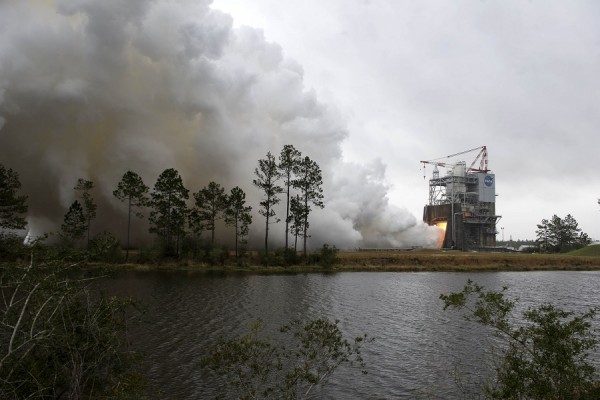By Ana Verayo, | March 14, 2016

NASA engineers conduct a successfully test firing of RS-25 rocket engine No. 2059 on the A-1 Test Stand at Stennis. The hot fire marks the first test of an RS-25 flight engine for NASA’s new Space Launch System vehicle.
NASA is now taking the necessary steps to finally realize its grand plan of sending humans to Mars for future colonization in the 2030s, as the space agency announced last Friday that it conducted a test fire of its powerful rocket engine that will eventually launch the Space Launch System.
Like Us on Facebook
The SLS will be the much awaited successor to NASA's Space Shuttle program that was terminated in 2011, which will be using a RS-25 rocket engine for the SLS' first launch that is slated for 2018.
According to engines manager Steve Wofford of NASA's Marshall Space Flight Center in Alabama, this test not only marks a crucial step in proving an effective design for the first flight of the SLS but it also gives a great feeling of anticipation since this engine once carried many astronauts into space before, and now, it is venturing out into space again for the first crewed mission of the SLS.
This confirms that the engines that will power the SLS missions are the exact same ones that are used to power the Space Shuttle program. These engines are so powerful that it was used in 135 space shuttle missions from 1981 to 2011 where four of them can provide a combined thrust of 2 million pounds that will now provide power to the SLS missions and future Martian missions.
Last October, the SLS rocket passed a battery of tests including a critical design review, making it NASA's most powerful rocket ever developed and manufactured. This is also the first vehicle to surpass NASA's Saturn V rocket that was utilized during the historic launches of the lunar Apollo missions in the 1960s.
NASA is working in collaboration with its contractor, AeroJet Rocketdyne as several tests were conducted on the RS-25 engine just last year that focuses on the controller and running tests on various operating conditions that will be experienced by the SLS.
This latest successful test will now help NASA and AeroJet Rocketdyne to work on new flight engine controllers and further running tests on the engines. According to the director of NASA's Stennis Space Center in Mississippi, Rick Gilbrech, this is definitely a great moment for NASA and the Space Center as there will be more exciting days to look forward to as the return to deep space and the future journey to Mars is heralded by this important rocket engine test.
-
Use of Coronavirus Pandemic Drones Raises Privacy Concerns: Drones Spread Fear, Local Officials Say

-
Coronavirus Hampers The Delivery Of Lockheed Martin F-35 Stealth Fighters For 2020

-
Instagram Speeds Up Plans to Add Account Memorialization Feature Due to COVID-19 Deaths

-
NASA: Perseverance Plans to Bring 'Mars Rock' to Earth in 2031

-
600 Dead And 3,000 In The Hospital as Iranians Believed Drinking High-Concentrations of Alcohol Can Cure The Coronavirus

-
600 Dead And 3,000 In The Hospital as Iranians Believed Drinking High-Concentrations of Alcohol Can Cure The Coronavirus

-
COVID-19: Doctors, Nurses Use Virtual Reality to Learn New Skills in Treating Coronavirus Patients







